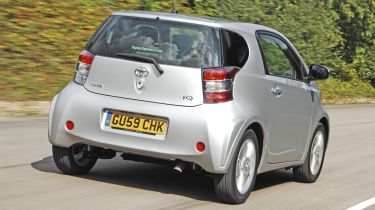Toyota iQ3 1.33
Does more powerful engine make innovative city car a winner?
The retro MINI and Fiat take inspiration from legends of the past, but Toyota’s designers had no such constraints with the iQ.
This is obvious inside and out, and the car’s clever use of space is closer in concept to that of the original Mini and 500 than either rival.
So, does the new 1.33-litre engine improve or detract from its novel design?
Stunted proportions and distinctive styling mean the iQ is quirky to say the least, and its curvy rear window line, big lights and chunky mirrors are at odds with the rest of the car. But its unique exterior hides a carefully packaged interior.
While Toyota claims the iQ is the world’s smallest four-seater, in reality it’s a comfortable three-seater with a cramped occasional fourth seat behind the driver. The large windscreen lets lots of light into the cabin, and the front seats feel more bright and airy than its rivals’.
Plus, by cutting away the passenger side of the dash and using a narrow centre console, Toyota has positioned the front passenger forward of the driver, freeing up legroom behind.
The cabin design is the least exciting here, with drab grey plastics and muted fabrics. But the iQ comes well equipped as standard. Buyers benefit from climate control and no fewer than nine airbags.
Used - available now

2023 Audi
Q4 Sportback e-tron
54,526 milesAutomaticElectric
Cash £23,363
2022 Kia
Niro
18,315 milesAutomaticPetrol1.6L
Cash £17,900
2023 Nissan
Juke
40,858 milesManualPetrol1.0L
Cash £12,287
2022 Volkswagen
T-Roc
36,779 milesAutomaticPetrol1.5L
Cash £18,600Quality is up there with the MINI, too, with solid, well-laid out switchgear.
Not everything is perfect, though. The seats don’t provide much side support and the single steering wheel-mounted control for the stereo takes some getting used to. As the iQ is over 550mm shorter than its rivals, the limited rear legroom comes as no surprise. Yet boot space is also tight, at 32 litres.
Fold the seat behind the driver, which offers zero legroom anyway, and it becomes more workable, while collapsing the other rear chair provides 238 litres of luggage capacity.
On the road, the iQ feels light and agile, and its tight turning circle is perfect for town driving.
The 1.33-litre engine is smooth and willing, and proved a decent performer. At the track, the Toyota covered 0-60mph in 10.9 seconds – only one-tenth slower than the Fiat. The gap widened at higher speeds, due to the Italian’s shorter gearing and more muscular torque.
Yet despite having a wheelbase of only two metres, the Toyota was composed over bumps, too. It rides well, and while there’s plenty of lean around tight corners, it grips keenly.
In terms of price, the Toyota is less competitive – it’s the most expensive car here. For the £11,615 outlay, you get the most equipment, though, and a range of options packs allows buyers to customise their car. Plus, Toyota’s new stop-start system cuts emissions, so the iQ’s road tax bill is only £35.
If you need a genuine four-seater, the iQ can’t compete –but family buyers aren’t likely to consider these models. As a distinctive, high-spec three-seater city car, with low running costs and an occasional extra seat, the Toyota makes sense.
Details
Chart position: 3
WHY: Novel iQ comes with more power and stop-start technology. It’s pricey, but is very well equipped.







